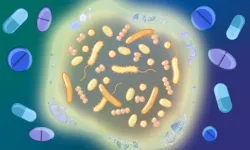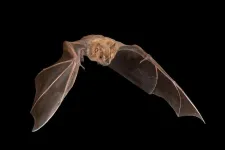(Press-News.org) The eye is an immune-privileged tissue because of the need to keep blood vessels away from the central pathway of light and to restrict entry of inflammatory cells that could cause damage. This has prompted questions about how the eye manages inflammation when it occurs.
A new study led by Thomas Jefferson University researchers has revealed insights into how the eye handles inflammation, particularly in autoimmune uveitis, an inflammatory disease that bypasses the eye’s immune privilege and can damage healthy eye tissue.
Previous studies by Jefferson researcher Sue Menko, PhD, revealed that immune cells populate the surface of the lens in response to acute injury and prolonged inflammation in other regions of the eye. While this was the first demonstration of immune cells recruited to the lens surface, it also raised questions about their role in ongoing surveillance, and whether they may help resolve the inflammation.
Her team’s latest study, published in The American Journal of Pathology, answers these questions. The researchers found that macrophages with an immunoregulatory phenotype and Tregs are the immune cells actively recruited to the lens surface during inflammation. These immunoregulatory cells help restore balance and reduce inflammation. They also found that these immune cells remain on the lens surface until the inflammation is resolved.
“Debunking the thought that the eye could not care for itself is a big deal,” says Dr. Menko. “This helps us understand disease processes like uveitis and how they're resolved in the eye. Maintaining a non-inflammatory condition in the eye is crucial to preserve vision, and we now know that the eye has inherent mechanisms to do that.”
MD-PhD student and first author Phuong Lee contributed to the study alongside researchers from the National Eye Institute and George Washington University.
The study highlights the importance of understanding the eye's natural defenses, which could eventually lead to more effective treatment strategies for autoimmune uveitis. The next steps in Dr. Menko’s research focus on uncovering the mechanisms that recruit immune cells to the lens and identifying the earliest alert systems that trigger this immunoregulatory inflammation in uveitis and other inflammatory eye conditions.
By Queen Muse
END
Researchers discover new role of immune cells in eye health
Study reveals new understanding of the eye’s natural defense against uveitis and inflammation
2024-09-24
ELSE PRESS RELEASES FROM THIS DATE:
Daniel R. Larson to receive 2025 Carolyn Cohen Innovation Award
2024-09-24
ROCKVILLE, MD – The Biophysical Society is pleased to announce that Daniel R. Larson, PhD, of the Center for Cancer Research at the National Cancer Institute within the National Institutes of Health, will receive the 2025 Carolyn Cohen Innovation Award. Larson will be honored at the Society’s 69th Annual Meeting, being held in Los Angeles, California from February 15-19, 2025.
Larson is being recognized for his pioneering contributions to the field of gene regulation using single-cell and single-molecule biophysical ...
James A. Glazier to receive 2025 Klaus Schulten and Zaida Luthey-Schulten Computational Biophysics Lecture Award
2024-09-24
ROCKVILLE, MD – The Biophysical Society is pleased to announce that James A. Glazier, PhD, of Indiana University, Bloomington, has been named the recipient of the 2025 Klaus Schulten and Zaida Luthey-Schulten Computational Biophysics Lecture Award. Glazier will be honored at the Society’s 69th Annual Meeting, being held in Los Angeles, California from February 15-19, 2025.
Glazier will be recognized for his development of algorithms, software, and models describing the emergent multicellular organization of development, homeostasis, and disease.
“I am delighted that the Biophysical Society is recognizing James’s pioneering work the ...
Better together: Gut microbiome communities’ resilience to drugs
2024-09-24
Many human medications can directly inhibit the growth and alter the function of the bacteria that constitute our gut microbiome. EMBL Heidelberg researchers have now discovered that this effect is reduced when bacteria form communities.
In a first-of-its-kind study, researchers from EMBL Heidelberg's Typas, Bork, Zimmermann, and Savitski groups, and many EMBL alumni, including Kiran Patil (MRC Toxicology Unit Cambridge, UK), Sarela Garcia-Santamarina (ITQB, Portugal), André Mateus (Umeå University, ...
More to munch on: The popcorn planet WASP-107b unveils new atmospheric details
2024-09-24
The "popcorn planet" is back in the spotlight! Using NASA's James Webb Space Telescope (JWST), a team of international astronomers has discovered new atmospheric details on WASP-107b, an exoplanet with a puffed-up atmosphere due to tidal heating. Previously described as an extremely low-density "popcorn planet" by researchers, WASP-107b has once again proven to be an intriguing subject, revealing even more surprising characteristics about its inflated and dynamic atmosphere.
WASP-107b, a gas giant about the size of Jupiter but with just one-tenth of its mass, has ...
Innovative electrolytes could transform steelmaking and beyond
2024-09-24
The lifeblood of any battery is the electrolyte. It is the medium through which positively charged elements (cations) migrate en masse between the positive and negative electrodes. By this means, batteries discharge to provide energy and charge to store energy. Scientists call this an electrochemical process.
Electrolytes are central to the development of different electrochemical processes, as well. For example, they could be used in converting iron ore into purified iron metal or iron alloys. A challenge is that the electrolyte must remain stable under extreme operating conditions and avoid side reactions that reduce energy efficiency. The payoff ...
Planting seeds for safer farming
2024-09-24
Per- and polyfluoroalkyl substances (PFAS) are human-made chemicals that were introduced in the 1940s. PFAS are used to create a variety of products including water-resistant clothing, non-stick cookware, and firefighting foams.
Unfortunately, PFAS can have negative effects on health, including increases in cholesterol levels and changes to liver function. Using PFAS-containing products can lead to their presence in the treated wastewater and treated sludge (referred to as biosolids). When grown on biosolid-amended farmland soils or irrigated with treated wastewater, crops can bioaccumulate PFAS. The PFAS-accumulated crops can be consumed directly by the public or indirectly ...
Fruit-only diet improves bats’ immune response to viruses
2024-09-24
Fruit bats generate more diverse antibodies than mice, but overall have a weaker antibody response, according to a new study published September 24th in the open-access journal PLOS Biology by Dan Crowley from Cornell University, USA, and colleagues.
Bats are well-known reservoirs for viruses with pandemic potential. While these viruses typically do not cause disease in bats, they can prove deadly in humans. Spillover events—transmission of a virus from a reservoir population (eg, bats) to a new host population ...
Placebo pain relief and positive treatment expectations are not caused by dopamine
2024-09-24
New findings argue against a direct causal role for dopamine during the experience of a treatment effect in the establishment of positive treatment expectations and placebo analgesia in healthy volunteers, according to a study published September 24th in the open-access journal PLOS Biology by Ulrike Bingel from University Hospital Essen, Germany, and colleagues.
Dopamine-based reward and learning mechanisms have been suggested to contribute to placebo effects. However, the exact role of the brain messenger molecule dopamine in their generation and maintenance is still unclear. ...
New guideline details how to manage CVD risk before, during & after noncardiac surgery
2024-09-24
Guideline highlights:
The American Heart Association and the American College of Cardiology joint guideline addressing cardiovascular evaluation and management of patients before, during and after noncardiac surgery reviews a decade of new evidence and provides updates since the last guideline in 2014.
The updates in the guideline are intended for patients scheduled for noncardiac surgery from preoperative evaluation through postoperative care and include appropriate use of cardiovascular testing and screening, management of cardiovascular conditions and risks, and recommendations for those taking sodium-glucose ...
Silvia Cavagnero to receive 2025 Emily M. Gray Award
2024-09-24
ROCKVILLE, MD – The Biophysical Society is pleased to announce that Silvia Cavagnero, PhD, of the University of Wisconsin-Madison, has been named the recipient of the 2025 Emily M. Gray Award. Cavagnero will be honored at the Society’s 69th Annual Meeting, being held in Los Angeles, California from February 15-19, 2025.
Cavagnero is being honored for developing courses, innovating instructional methods, mentoring students at all levels, and promoting diversity in biophysics.
“Silvia is an accomplished biophysicist and a born educator,” ...
LAST 30 PRESS RELEASES:
Estimating unemployment rates with social media data
Climate policies can backfire by eroding “green” values, study finds
Too much screen time too soon? A*STAR study links infant screen exposure to brain changes and teen anxiety
Global psychiatry mourns Professor Dan Stein, visionary who transformed mental health science across Africa and beyond
KIST develops eco-friendly palladium recovery technology to safeguard resource security
Statins significantly reduce mortality risk for adults with diabetes, regardless of cardiovascular risk
Brain immune cells may drive more damage in females than males with Alzheimer’s
Evidence-based recommendations empower clinicians to manage epilepsy in pregnancy
Fungus turns bark beetles’ defenses against them
There are new antivirals being tested for herpesviruses. Scientists now know how they work
CDI scientist, colleagues author review of global burden of fungus Candida auris
How does stroke influence speech comprehension?
B cells transiently unlock their plasticity, risking lymphoma development
Advanced AI dodel predicts spoken language outcomes in deaf children after cochlear implants
Multimodal imaging-based cerebral blood flow prediction model development in simulated microgravity
Accelerated streaming subgraph matching framework is faster, more robust, and scalable
Gestational diabetes rose every year in the US since 2016
OHSU researchers find breast cancer drug boosts leukemia treatment
Fear and medical misinformation regarding risk of progression or recurrence among patients with breast cancer
Glucagonlike peptide-1 receptor agonists and asthma risk in adolescents with obesity
Reviving dormant immunity: Millimeter waves reprogram the immunosuppressive microenvironment to potentiate immunotherapy without obvious side effects
Safety decision-making for autonomous vehicles integrating passenger physiological states by fNIRS
Fires could emit more air pollution than previously estimated
A new way to map how cells choose their fate
Numbers in our sights affect how we perceive space
SIMJ announces global collaborative book project in commemoration of its 75th anniversary
Air pollution exposure and birth weight
Obstructive sleep apnea risk and mental health conditions among older adults
How talking slows eye movements behind the wheel
The Ceramic Society of Japan’s Oxoate Ceramics Research Association launches new international book project
[Press-News.org] Researchers discover new role of immune cells in eye healthStudy reveals new understanding of the eye’s natural defense against uveitis and inflammation



